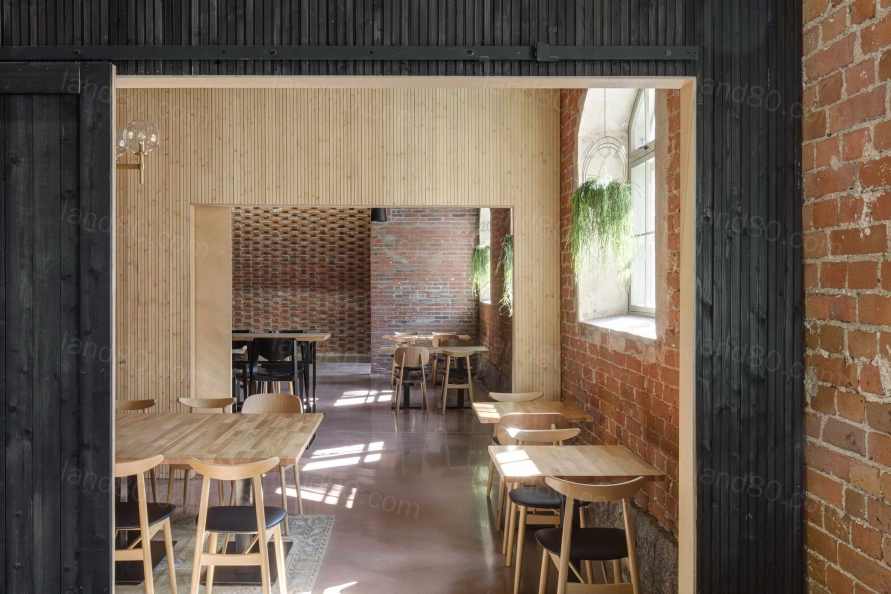由于经济上的衰退,这座位于Seinäjoki镇中心边缘的建筑没有成为Törnavä庄园标志性牛棚。事实上,同样的不幸也导致了周围城市的发展,并最终发展成为一个城市。牛棚本身最终被保险公司Kaleva完成,先是变成了一个宽布厂,最后被芬兰国防军(FinnishDefenceForces)关闭,不对公众开放。
Due to economic misfortunes, this building
on the edge of Seinäjoki town centre never became Törnavä Manor’s exemplary
educational cowshed as originally intended. In fact the same misfortunes led to
the development and growth of the surrounding municipality into an eventual
city. The cowshed itself was eventually finished by the insurance company
Kaleva, first turned into a broadcloth factory and then finally closed off from
public by the Finnish DefenceForces.


今天,牛棚已经重新成为的艺术和文化中心。建筑在其整个生命周期中根据情景需求逐渐增长,但却是理性的。例如,在1893年到1930年间,它曾因不同的目的被提高和延长。由于没有一个历史时代是真正原创的,每一个过去的十年都有自己的故事,所以不可能简单地还原到某个特定的时代。虽然牛棚的外部在塞伊奈约基的城市景观中非常突出,但建筑内部仍然难以进入,通常不为公众所知。作为设计师,这种公众认可和信息匮乏之间的矛盾局面,激发了设计师对项目的想象力和灵感。
Today, the barn has re-emerged as a centre
for arts and culture co-operated by several entities. The building has grown
piecemeal but rationally throughout its life based on situational needs. For
instance, it has been raised and lengthened for various purposes between
1893–1930. Since no single historical era is truly original as each decade
passed has its own story, it was not possible to simply restore to a certain
era. Whilst the exterior of the cowshed is prominent in the cityscape of
Seinäjoki, the building interiors however, have remained inaccessible and
generally unknown to the public. As designers, this paradoxical situation
between public recognition and lack of information gave rise to imagination and
inspiration in responding to the project.
修复工作是关于不断寻求建筑的平衡、确认和重新诠释。负责任的建筑干预应该提供发明和创造新事物的手段,同时保护历史的痕迹。对我们来说,现象学的方法是合适的。场地就在附近,我们可以经常参观建筑,记录建筑过程中的材料、层次和阶段,同时我们能够彻底地将建筑分解成一个叙事,然后我们可以将其应用到建筑表达中。
Restoration work is about continuously
seeking balance, validation and reinterpretation of the building. Responsible
architectural intervention should offer the means to invent and create
something new, while safeguarding the traces of history. To us, a
phenomenological approach felt appropriate. The site was nearby and we could
visit the building often to document materials, layers and phases in the
building process whilst we were able to thoroughly dissected the building into
a narrative which we could then be applied in the architectural expression.




KalevanNavetta艺术和文化中心是建筑中各种实体的集合。大厅作为其他空间的前奏。黑暗的,位于中心的楼梯准备体验气氛、结构和主要空间之间的材料的戏剧性变化,就像一种乡村交响乐。通过这种方式,建筑成为一种丰富的感官体验,类似于聆听由民间小提琴家、木工刨床和音乐会钢琴同时演奏的音乐。
The KalevanNavetta Art and Culture Centre
is an ensemble of the various entities that occupy the building. The lobby acts
as a prelude for the rest of the spaces. The dark, centrally located staircase
prepares one in experiencing the theatrical shift in atmospheres, structures
and materials between the main spaces, like a kind of rustic symphony. In this
way the building becomes a rich sensual experience, akin to listening to music
performed simultaneously by folk violinists, wood planer machines and concert
piano.

▽场地平面图 Site plan

▽一层平面图 First floor plan

▽二层平面图 Second floor plan

▽三层平面图 Third floor plan

▽立面图 Elevation

▽立面图 Elevation

Project Name: Art and Culture Center
KalevanNavetta
Architecture Firm: Hirvilammi Architects
Ltd.
Website: www.hirvilammi.archi
Contact e-mail: teemu@hirvilammi.archi
Firm Location: Finland, Seinäjoki
Completion Year: 2020
Gross Built Area: 4478 m2
Project location: Seinäjoki, Finland
Lead Architects: Teemu Hirvilammi, Anne
Kaivo-oja
Lead Architects e-mail: teemu@hirvilammi.archi
Design Team: Hirvilammi Architects Ltd. /
Teemu Hirvilammi and Anne Kaivo-oja
Clients: Pihlacon / Petri Pihlajaniemi
Users: Sibelius Academy Seinäjoki Unit
Cultural cervices Seinäjoki, KunsthalleSeinäjoki, Childrens cultural center, Louhimo,
Seinäjoki Vocational college, Restaurant, Äärellä, Taito Etelä-Pohjanmaa,
crafts and design, school Näppi, Taito Shop,
Engineering: Ramboll Finland / Structure
engineering / Fire engineering, SähköTuominiemi / Electrical, Paloff oy / HVAC
Interior design: Teemu Hirvilammi and Anne
Kaivo-oja, Elina Ristimaa, Room2, (Taito Shop)
Photo credits: Hirvilammi architects
|